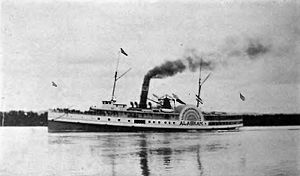Alaskan (sidewheeler)
 |
|
| History | |
|---|---|
| Name: | Alaskan |
| Owner: |
|
| Route: | Columbia River, Puget Sound |
| Builder: | John Roach & Son |
| Cost: | $350,000 |
| Launched: | August 8, 1883 |
| Completed: | 1883 |
| In service: | April 6, 1884 |
| Fate: | Foundered May 12, 1889 |
| Notes: | iron hull, built in Chester, Pennsylvania |
| General characteristics | |
| Type: | inland steamship |
| Tonnage: | 1718 |
| Length: | 276 ft (84 m) |
| Beam: | 39.6 ft (12.1 m) |
| Depth: | 14.5 ft (4.4 m) depth of hold |
| Decks: | three (freight, passenger, hurricane) |
| Installed power: | Coal-fired boiler, single-cylinder walking beam engine |
| Propulsion: | sidewheels |
| Sail plan: | schooner (auxiliary) |
| Notes: | Near sistership to Olympian |
The steamship Alaskan operated from 1884 to 1889 on the Columbia River and Puget Sound. Alaskan and her near-sistership Olympian were known as “Henry Villard’s White Elephants.” There were a number of vessels named Alaska and Alaskan, this large side-wheel steamboat should not be confused with them.
Alaskan was built in 1883 in Chester, Pennsylvania. She was a sidewheeler driven by a single cylinder vertical condensing walking-beam steam engine, which gave her high speed. Her iron hull was 276 feet (84 m) long, and she was rated at 1718 tons. She was built primarily for service on Puget Sound.
In 1884, Alaskan was brought to the Pacific Northwest through the Strait of Magellan, around South America. Alaskan and Olympian were built to designs popular and successful on Chesapeake Bay. When she arrived in the Pacific Northwest this design proved unsuited for the conditions, and the ship became a steady money loser. Timmen, one of the leading marine historians of the Pacific Northwest, states of Henry Villard that “[t]his financial genius, who once monopolized the Northwest’s rail and water transportation, must have suffered a lapse of common sense when he ordered the pair constructed in Delaware.”
Villard's company, the Oregon Railway and Navigation Company first placed Alaskan in service on the Columbia River, where because of her huge size, she could only operate on the deeper water from Portland to Astoria. Her first set of officers included master Capt. James W. Troup (1856–1932), pilot Archie Pease, and engineer Thomas Smith. Alaskan’s chief rival on this route was U.B. Scott’s Telephone, supposedly then the fastest steamboat in the world. Occasionally the highly skilled Troup and Pease were able to outrun Telephone, then under the command of the equally-skilled river veterans Capt. William H. Whitcomb (1851–1924) and chief engineer Newton Scott. Both Alaskan and Olympian proved too expensive to operate on the Columbia River. The main problem was that they consumed huge quantities of expensive coal.
...
Wikipedia
